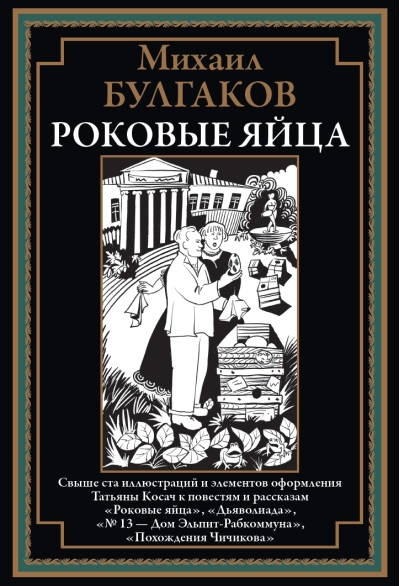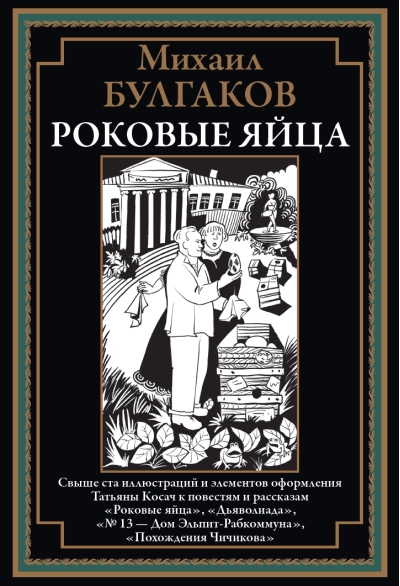Fatal eggs
9.99 €
The only thing available 1
Mikhail Afanasyevich Bulgakov's first major work was his novel The White Guard. It began to be published in 1925 on the pages of the magazine "Russia".
In this work Bulgakov acted as a strong realist, subtly reflecting both the whirlwinds of revolutionary events and the experiences of his characters. Not without reason Maximilian Voloshin wrote that this novel can be compared to the debut publications of Dostoevsky or Tolstoy. The same scalding realism imbued and Bulgakov's stories from the cycle "Notes of a Young Doctor".
However, the talent of the writer was wider than the ability to reflect the surrounding reality. We know another Bulgakov - a fantasist, imaginative, even fantastical, able to twist a completely improbable plot and set it out with a compelling authenticity. Bulgakov brought to the Russian literature of the first third of XX century what it very often lacked earlier - entertainment, intrigue, sparkling plot.
The story "Fatal Eggs" - a brilliant example of this. Its fabula, fantastic and incredible, fascinating, mesmerizing, does not allow you to tear yourself away from reading. It is full of "the most terrible and inexplicable" events and amazing surprises. At the same time, Bulgakov lays out his incredible plot smilingly, ironically, in a quasi-serious tone. This is not the fiction of H.G. Wells or Belyaev, in which futuristic constructions are built on very real technological ground. Bulgakov's fantastic play does not need such soil.
The same sly fire of the irrepressible fantasist illuminates and "Devoliada" - a story about how the twins ruined the clerk. As in "Fatal Eggs", here everything is built on chance, from which the most incredible consequences follow. In both novels Bulgakov gently mocks and even slyly mocks life, pouring its contents into fantastic forms, within which all the details of Soviet life are surprisingly preserved. Without this marvelous skill, which Bulgakov possessed to the fullest extent, neither his "Dog's Heart" nor "The Master and Margarita" would have appeared later.
The book is illustrated with drawings by contemporary St. Petersburg artist Tatiana Kosach. She graduated from the History Department of St. Petersburg State University and is a specialist in the art of the Middle Ages. Her iconographic and graphic works can be found in private collections of art lovers in Russia, USA, Italy and France.
In the series "Library of World Literature" her illustrations decorate the novels "American Tragedy", "The Financier", "Titan", "Stoic" by Theodore Dreiser, "Doctor Zhivago" by Boris Pasternak, "The White Guard" by Mikhail Afanasievich Bulgakov and short stories by Ambrose Bierce.
In this work Bulgakov acted as a strong realist, subtly reflecting both the whirlwinds of revolutionary events and the experiences of his characters. Not without reason Maximilian Voloshin wrote that this novel can be compared to the debut publications of Dostoevsky or Tolstoy. The same scalding realism imbued and Bulgakov's stories from the cycle "Notes of a Young Doctor".
However, the talent of the writer was wider than the ability to reflect the surrounding reality. We know another Bulgakov - a fantasist, imaginative, even fantastical, able to twist a completely improbable plot and set it out with a compelling authenticity. Bulgakov brought to the Russian literature of the first third of XX century what it very often lacked earlier - entertainment, intrigue, sparkling plot.
The story "Fatal Eggs" - a brilliant example of this. Its fabula, fantastic and incredible, fascinating, mesmerizing, does not allow you to tear yourself away from reading. It is full of "the most terrible and inexplicable" events and amazing surprises. At the same time, Bulgakov lays out his incredible plot smilingly, ironically, in a quasi-serious tone. This is not the fiction of H.G. Wells or Belyaev, in which futuristic constructions are built on very real technological ground. Bulgakov's fantastic play does not need such soil.
The same sly fire of the irrepressible fantasist illuminates and "Devoliada" - a story about how the twins ruined the clerk. As in "Fatal Eggs", here everything is built on chance, from which the most incredible consequences follow. In both novels Bulgakov gently mocks and even slyly mocks life, pouring its contents into fantastic forms, within which all the details of Soviet life are surprisingly preserved. Without this marvelous skill, which Bulgakov possessed to the fullest extent, neither his "Dog's Heart" nor "The Master and Margarita" would have appeared later.
The book is illustrated with drawings by contemporary St. Petersburg artist Tatiana Kosach. She graduated from the History Department of St. Petersburg State University and is a specialist in the art of the Middle Ages. Her iconographic and graphic works can be found in private collections of art lovers in Russia, USA, Italy and France.
In the series "Library of World Literature" her illustrations decorate the novels "American Tragedy", "The Financier", "Titan", "Stoic" by Theodore Dreiser, "Doctor Zhivago" by Boris Pasternak, "The White Guard" by Mikhail Afanasievich Bulgakov and short stories by Ambrose Bierce.
See also:
- All books by the publisher
- All books by the author
- All books in the series Library of World Literature





















































